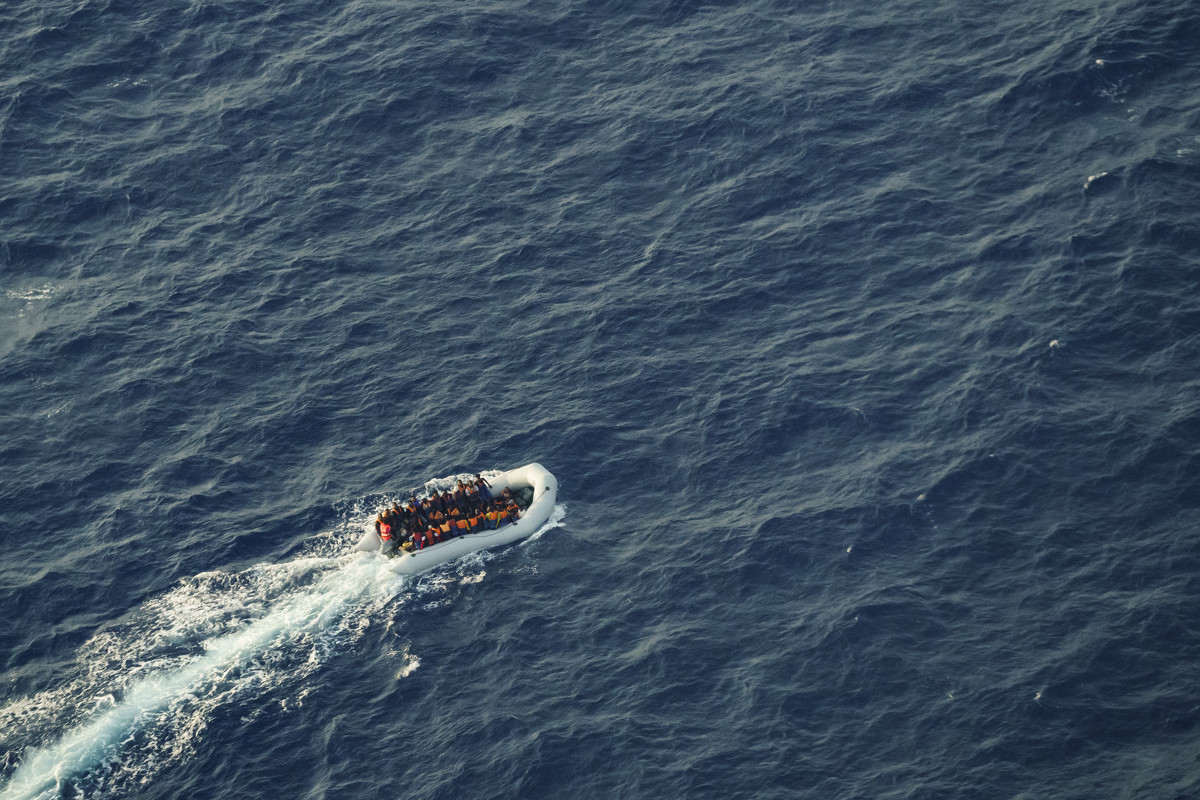
African migrants attempting to cross the Mediterranean Sea from Libya to Italy in a rubber boat Tuesday, Oct. 5, 2021, look up at the Seabird, a humanitarian aircraft flying over them. At least 23,000 people have died or disappeared trying to reach Europe since 2014, according to the United Nations' migration agency. Despite the risks, many migrants say they'd rather die trying to reach Europe than be returned to Libya. (AP Photo/Renata Brito)
ABOARD THE SEABIRD (AP) - As dozens of African migrants traversed the Mediterranean Sea on a flimsy white rubber boat, a small aircraft circling 1,000 feet above closely monitored their attempt to reach Europe.
The twin-engine Seabird, owned by the German non-governmental organization Sea-Watch, is tasked with documenting human rights violations committed against migrants at sea and relaying distress cases to nearby ships and authorities who have increasingly ignored their pleas.
On this cloudy October afternoon, an approaching thunderstorm heightened the dangers for the overcrowded boat. Nearly 23,000 people have died or gone missing in the Mediterranean trying to reach Europe since 2014, according to the United Nations' migration agency.
"Nour 2, Nour 2, this is aircraft Seabird, aircraft Seabird," the aircraft's tactical coordinator, Eike Bretschneider, communicated via radio with the only vessel nearby. The captain of the Nour 2, agreed to change course and check up on the flimsy boat. But after seeing the boat had a Libyan flag, the people refused its assistance, the captain reported back on the crackling radio.

Eike Bretschneider exits the Seabird aircraft after flying for nearly six hours before running low on fuel over the Mediterranean Sea north of Libya, as a storm approaches the island of Lampedusa, Italy, Tuesday, Oct. 5, 2021. The twin-engine Seabird, owned by the German non-governmental organization Sea-Watch, is tasked with documenting human rights violations committed against migrants at sea and relaying distress cases to nearby ships and authorities who have increasingly ignored their pleas. The plane had to leave the scene without knowing the fate of the people, but a day later, got good news: They had made it safely to Europe. (AP Photo/Renata Brito)
"They say they only have 20 liters of fuel left," the captain, who did not identify himself by name, told the Seabird. "They want to continue on their journey."
The small boat's destination was the Italian island of Lampedusa, where tourists sitting in outdoor cafés sipped on Aperol Spritz, oblivious to what was unfolding 60 nautical miles (111 kilometers/68 miles) south of them on the Mediterranean Sea.
Bretschneider, a 30-year-old social worker, made some quick calculations and concluded the migrants must have departed Libya approximately 20 hours ago and still had some 15 hours ahead of them before they reached Lampedusa. That was if their boat did not fall apart or capsize along the way.
Despite the risks, many migrants and refugees say they'd rather die trying to cross to Europe than be returned to Libya where, upon disembarkation, they are placed in detention centers and often subjected to relentless abuse.
Bretschneider sent the rubber boat's coordinates to the air liaison officer sitting in Berlin, who then relayed the position (inside the Maltese Search and Rescue zone) to both Malta and Italy. Unsurprisingly to them, they received no response.
Running low on fuel, the Seabird had to leave the scene.
"We can only hope the people will reach the shore at some moment or will get rescued by a European coast guard vessel," Bretschneider told AP as they made their way back.
The activists have grown used to having their distress calls go unanswered.

African migrants sit without life vests on an overcrowded blue wooden boat in the Mediterranean Sea between North Africa and the Italian island of Lampedusa, Saturday, Oct. 4, 2021, as seen from aboard the humanitarian aircraft Seabird. The Seabird, owned and operated by the German NGO Sea-Watch, seeks to monitor human rights violations at sea and assist in migrant rescues. (AP Photo/Renata Brito)
For years human rights groups and international law experts have denounced that European countries are increasingly ignoring their international obligations to rescue migrants at sea. Instead, they've outsourced rescues to the Libyan Coast Guard, which has a track record of reckless interceptions as well as ties to human traffickers and militias.
"I'm sorry, we don't speak with NGOs," a man answering the phone of the Maltese Rescue and Coordination Center told a member of Sea-Watch inquiring about a boat in distress this past June. In a separate call to the Rescue and Coordination Center in Rome, another Sea-Watch member was told: "We have no information to report to you."
Maltese and Italian authorities did not respond to questions sent by AP.
Trying to get in touch with the Libyan rescue and coordination center is an even greater challenge. On the rare occasion that someone does pick up, the person on the other side of the line often doesn't speak English.
More than 49,000 migrants have reached Italian shores so far this year according to the Italian Ministry of Interior, nearly double the number of people who crossed in the same time period last year.
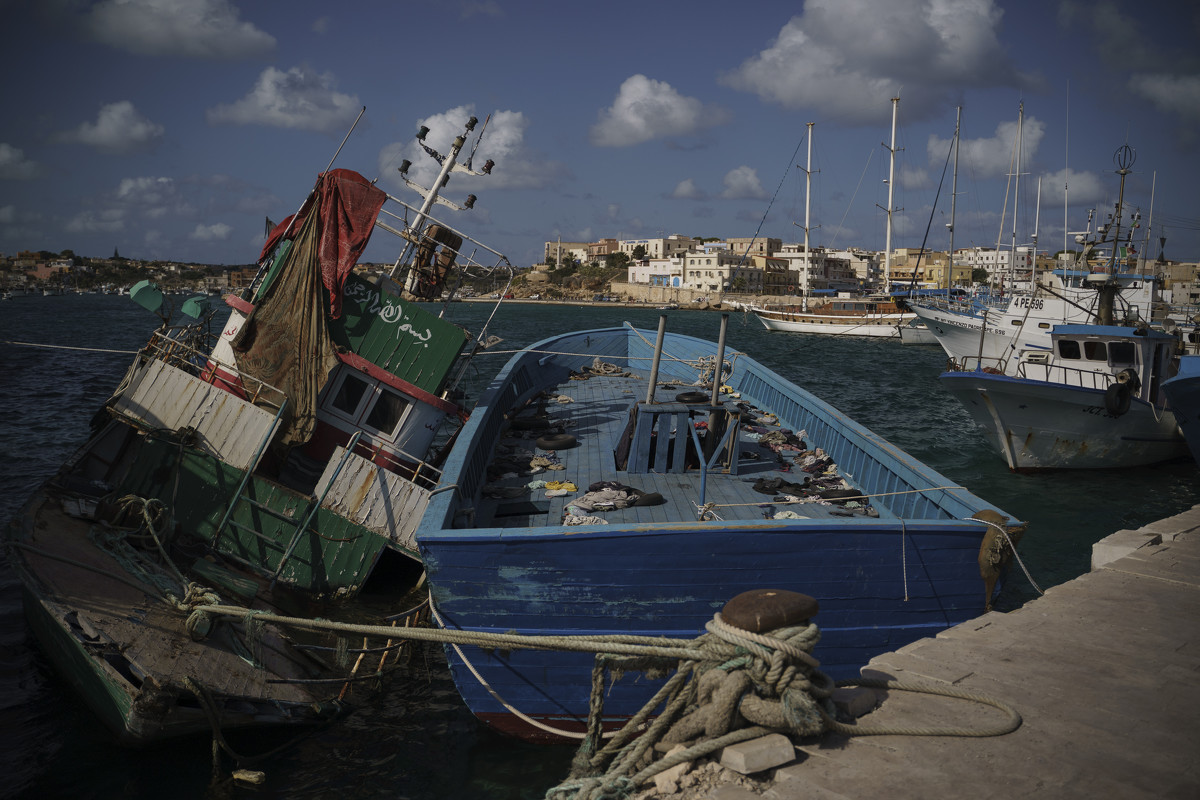
Empty boats used by migrants to cross the Mediterranean Sea from Libya to Italy are tied to the docks on the island of Lampedusa, Italy, Thursday, Sept. 30, 2021. Despite the risks, many migrants and refugees say they'd rather die trying to cross to Europe than be returned to Libya where, upon disembarkation, they are placed in detention centers and often subjected to relentless abuse. (AP Photo/Renata Brito)
Although it is illegal for European vessels to take rescued migrants back to Libya themselves, information shared by the EU's surveillance drones and planes have allowed the Libyan Coast Guard to considerably increase its ability to stop migrants from reaching Europe. So far this year, it has intercepted roughly half of those who have attempted to leave, returning more than 26,000 men, women and children to Libya.
Sea-Watch has relied on millions of euros from individual donations over several years to expand its air monitoring capabilities as well. It now has two small aircraft that, with a birds-eye view, can find boats in distress much faster than ships can.
Taking off from Lampedusa, which is closer to North Africa than Italy, the planes can reach a distress case relatively quickly if its position is known. But when there are no exact coordinates, they must fly a search pattern, sometimes for hours, and scan the sea with the help of binoculars.

German volunteers Leona Blankenstein, left, and David Lohmueller search from aboard the Seabird, a humanitarian monitoring aircraft, for migrant boats in distress as they fly over the Mediterranean Sea between Libya and the Italian island of Lampedusa, Tuesday, Oct. 5, 2021. The plane, owned by the German non-governmental organization Sea-Watch, is tasked with documenting human rights violations committed against migrants at sea and relaying distress cases to nearby ships and authorities who have increasingly ignored their pleas. (AP Photo/Renata Brito)
Even when flying low, finding a tiny boat in the vast Mediterranean can strain the most experienced eyes. The three- to four-person crew of volunteers reports every little dot on the horizon that could potentially be people in distress.
"Target at 10 o'clock," the Seabird's photographer sitting in the back alerted on a recent flight.
The pilot veered left to inspect it.
"Fishing boat, disregard," Bretschneider, the tactical coordinator, replied.
In rough seas, breaking waves can play tricks and for brief moments resemble wobbly boats in the distance. Frequently, the "targets" turn out to be nothing at all, and the Seabird returns to land hours later without any new information.
But finding boats in distress is only the first challenge. Getting them rescued is just as difficult, if not harder.

Felix Weiss, who heads Sea-Watch's airborne operations points to a map of the Mediterranean Sea during an interview in Lampedusa, Italy, Tuesday, Oct. 5, 2021. Sea-Watch is tasked with documenting human rights violations committed against migrants at sea and relaying distress cases to nearby ships and authorities who have increasingly ignored their pleas. (AP Photo/Renata Brito)
With the absence of state rescue vessels and NGO ships getting increasingly blocked from leaving port, Sea-Watch often relies on the good will of merchant vessels navigating the area. But many are also reluctant to get involved after several commercial ships found themselves stuck at sea for days as they waited for Italy's or Malta's permission to disembark rescued migrants. Others have taken them back to Libya in violation of maritime and refugee conventions.
This week, a court in Naples convicted the captain of an Italian commercial ship for returning 101 migrants to Libya in 2018.
Without any state authority, the Seabird can only remind captains of their duty to rescue persons in distress. In this way, Bretschneider recently got an Italian supply vessel to save 65 people from a drifting migrant boat, just moments before the Libyan Coast Guard arrived.
On another mission a few days later, the Seabird returned from its flight without knowing what would happen to the people they had seen on the white rubber boat.
Bretschneider checked his phone at dinner that night, hoping for good news. On the other side of the Mediterranean, 17 bodies had washed up in western Libya, apparently from a different boat.
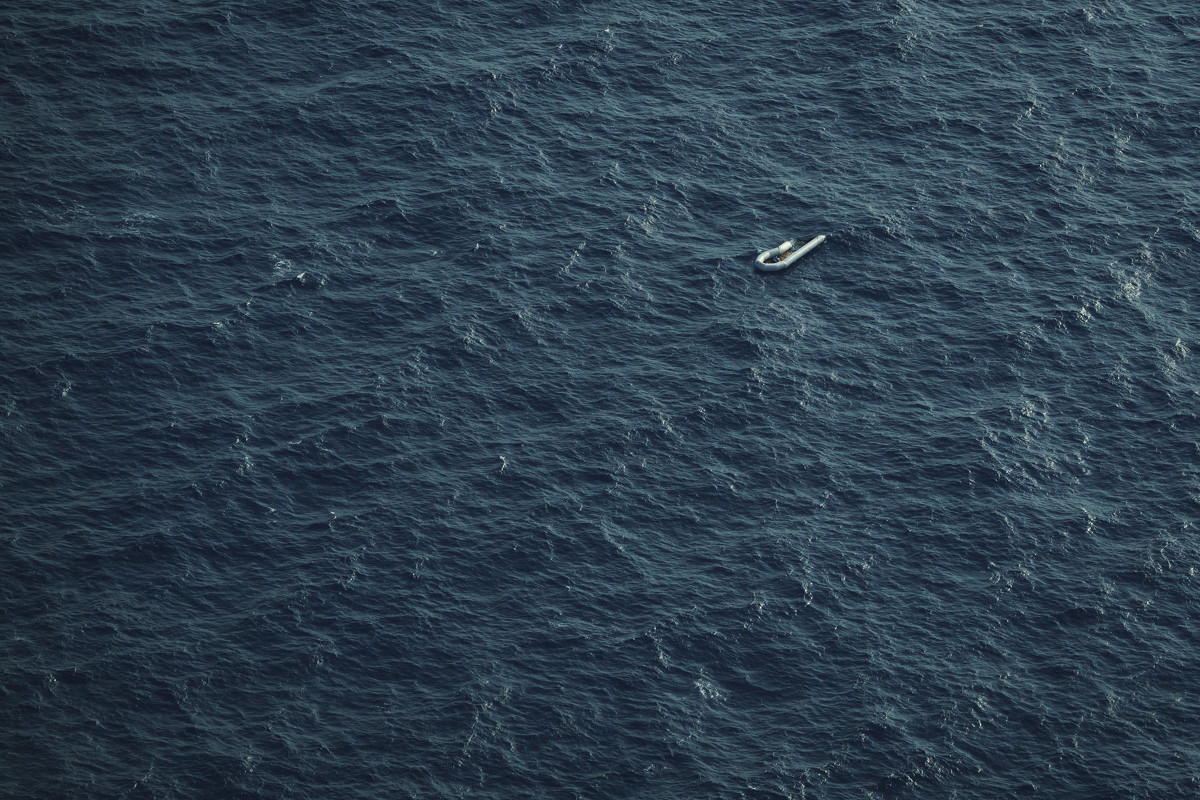
A partially deflated and empty rubber boat, probably used by migrants, floats in the Mediterranean Sea between Libya and Italy, on Monday, Oct. 4, 2021, as seen from aboard the humanitarian aircraft Seabird. At least 23,000 people have died or disappeared trying to reach Europe since 2014, according to the United Nations' migration agency. Despite the risks, many migrants say they'd rather die trying to reach Europe than be returned to Libya. (AP Photo/Renata Brito)
The next day the Seabird took off to look for the white rubber boat again, in vain. On their way back, they got a message from land.
The white rubber boat had reached waters near Lampedusa and was picked up by the Italian Coast Guard. The people had made it.
___
Follow all AP stories on global migration at https://apnews.com/hub/migration.
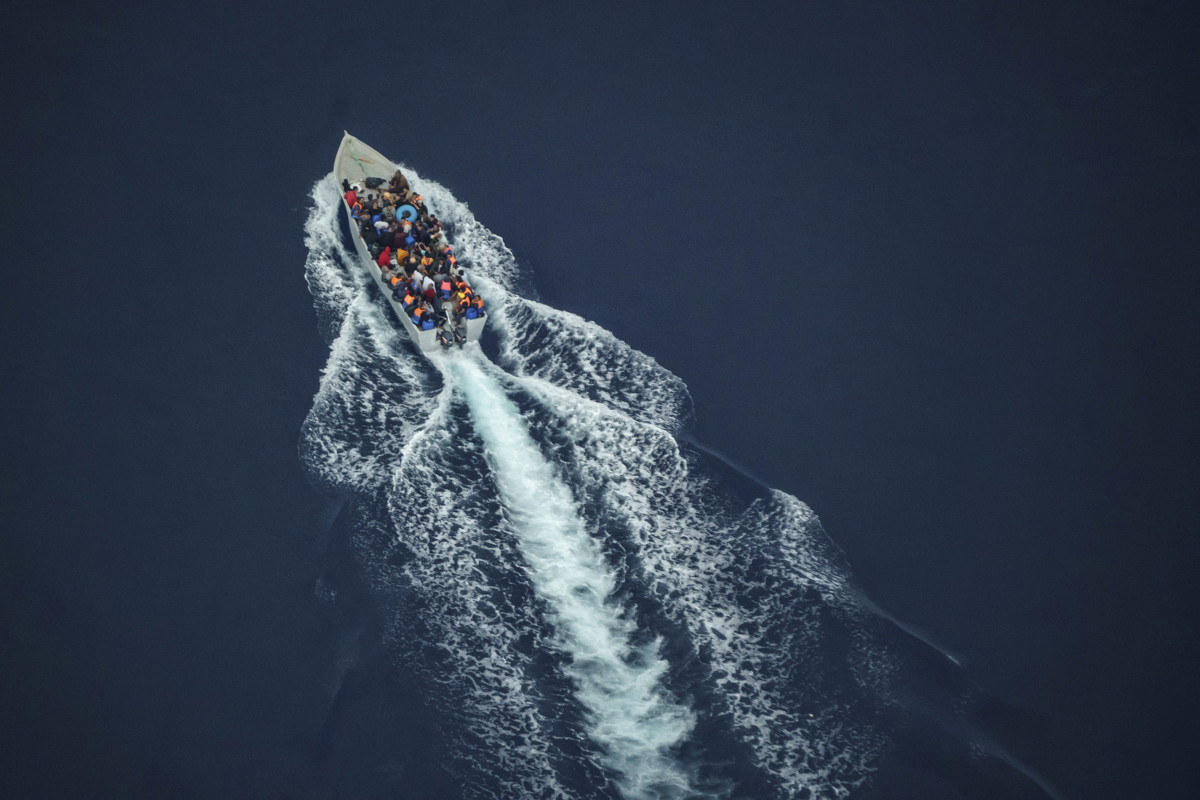
Migrants navigate on an overcrowded wooden boat in the Central Mediterranean Sea between North Africa and the Italian island of Lampedusa, Saturday, Oct. 2, 2021, as seen from aboard the humanitarian aircraft Seabird. At least 23,000 people have died or disappeared trying to reach Europe since 2014, according to the United Nations' migration agency. Despite the risks, many migrants say they'd rather die trying to reach Europe than be returned to Libya. (AP Photo/Renata Brito)
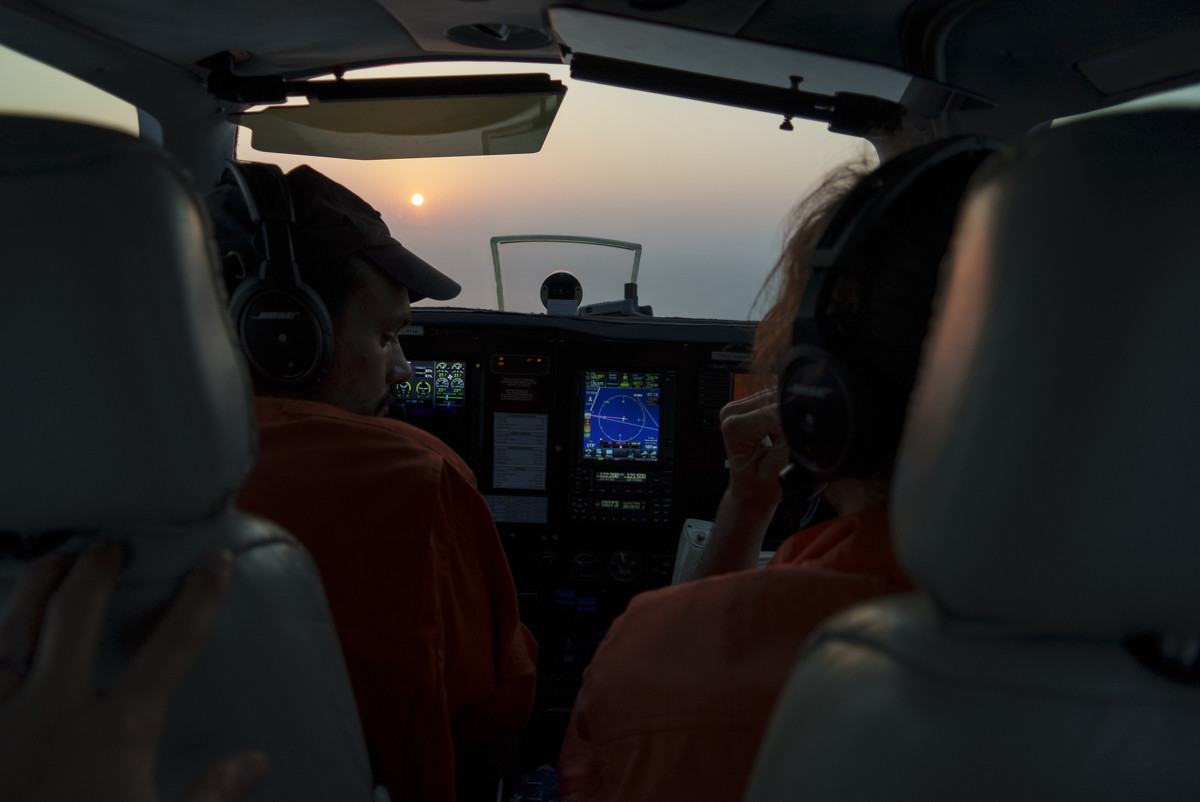
Volunteer French pilot Augustin Clot, left, and tactical coordinator Jakob Fruehmann, of Austria, talk inside the cockpit of the humanitarian monitoring aircraft Seabird, as they search for migrant boats in distress in the Mediterranean Sea between Libya and the Italian island of Lampedusa, Monday, Oct. 4, 2021. The plane, owned and operated by the German NGO Sea-Watch, seeks to monitor human rights violations at sea and assist in migrant rescues. (AP Photo/Renata Brito)
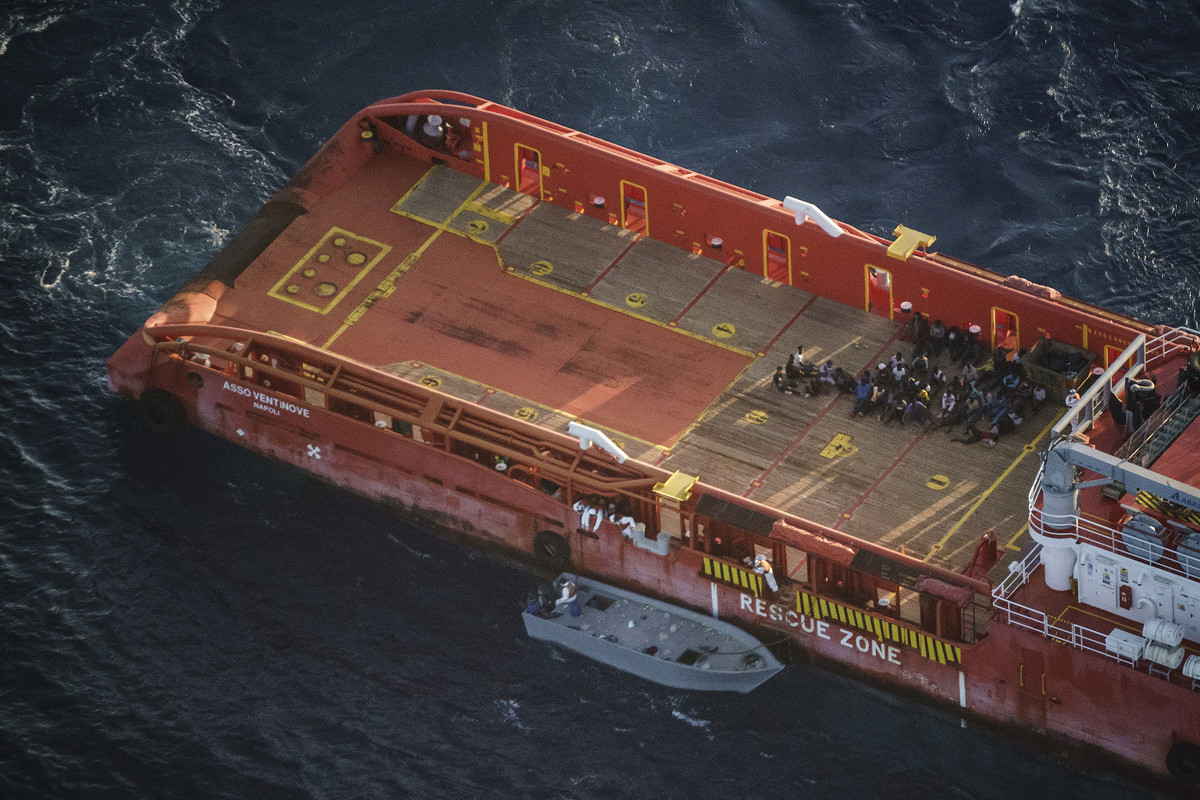
Migrants sit on the deck of the Italian supply vessel Asso Ventinove after they were rescued from an unseaworthy boat drifting in the Mediterranean Sea near the Bouri oilfields north of Libya, Saturday, Oct. 2, 2021, as seen from aboard the humanitarian aircraft Seabird. The offshore supply vessel rescued dozens of migrants, including women and children, fleeing Libya to Europe on a crowded, wooden boat. (AP Photo/Renata Brito)

Migrants who crossed the Mediterranean Sea by boat line up behind a fence in Lampedusa, Italy, Friday, Oct. 1, 2021, as they wait to board a ferry to Sicily. Despite the risks, many migrants and refugees say they'd rather die trying to cross to Europe than be returned to Libya where, upon disembarkation, they are placed in detention centers and often subjected to relentless abuse. (AP Photo/Renata Brito)
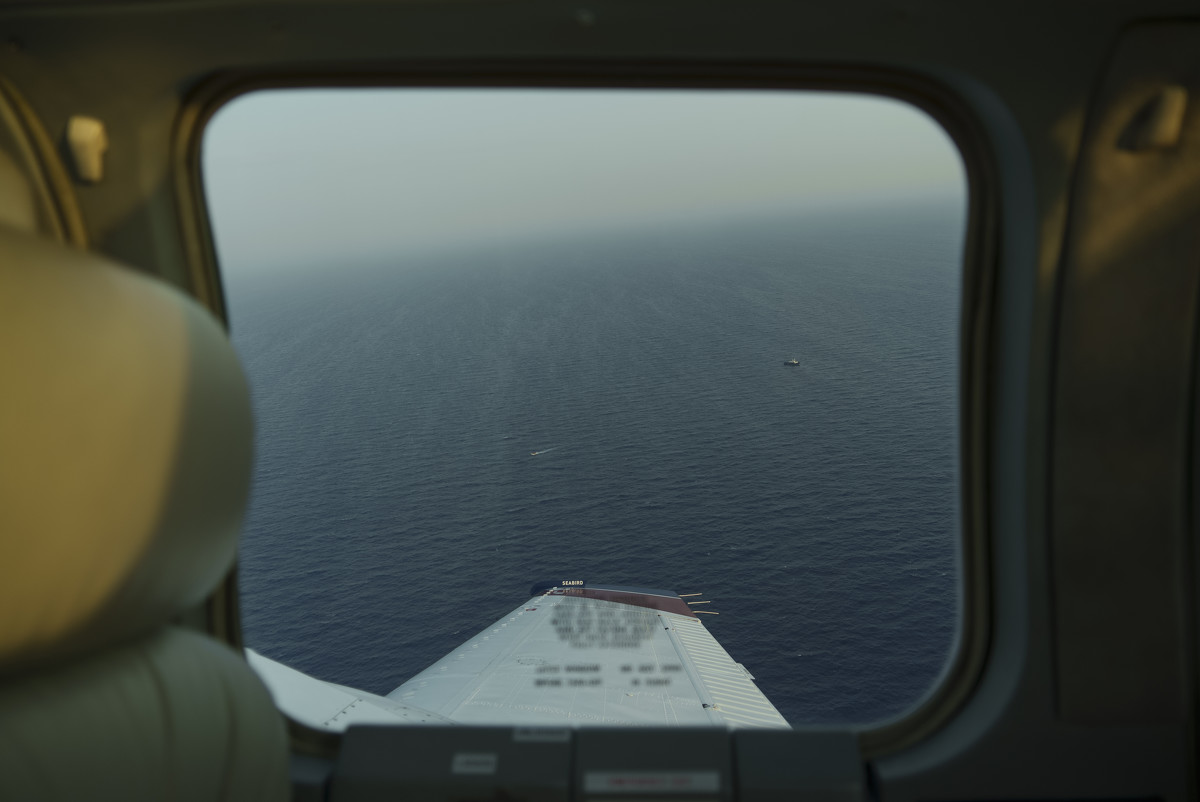
A small migrant boat, left, and a Libyan merchant vessel are visible through the window of the humanitarian aircraft Seabird, above the Mediterranean Sea between Libya and Italy, Tuesday, Oct. 5, 2021. The unseaworthy boat was spotted by the Seabird, a monitoring aircraft operated by the Sea-Watch non-governmental organization that seeks to monitor human rights violations and assist in the rescue of migrants fleeing Libya to Europe by boat on the Mediterranean Sea. (AP Photo/Renata Brito)